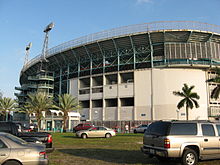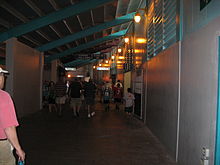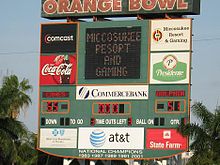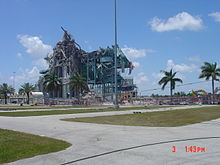- Miami Orange Bowl
-
Miami Orange Bowl 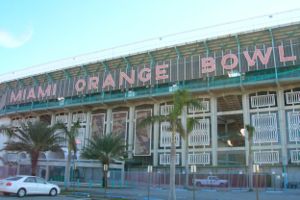
Former names Burdine Stadium (1937–59) Location 1501 NW 3rd Street
Miami, Florida 33125
USACoordinates 25°46′40.98″N 80°13′11.31″W / 25.77805°N 80.2198083°WCoordinates: 25°46′40.98″N 80°13′11.31″W / 25.77805°N 80.2198083°W Broke ground 1936 Opened December 10, 1937 Expanded 1944, 1947, 1950, 1953, 1955, 1968 Closed January 26, 2008 Demolished May 14, 2008 Owner City of Miami Operator City of Miami Surface Natural grass – (1976–2008)
PolyTurf – (1970–75)
Natural grass – (1937–69)Construction cost $340,000 USD
($5.2 million in 2011 dollars[1])Capacity 23,330 (1937–1943)[2]
35,030 (1944–1946)[2]
59,578 (1947–1949)[2]
64,552 (1950–1952)[2]
67,129 (1953–1954)[2]
76,062 (1955–1960)[2]
72,880 (1961–1962)[3]
70,097 (1963–1967)[4]
80,010 (1968–1976)[2]
80,045 (1977–1980)[5]
75,500 (1981–1990)[2]
74,712 (1991–1993)[2]
74,476 (1994–2002)[2]
72,319 (2003–2007)[2]Tenants Miami Hurricanes (NCAA) (1937–2007)
FIU Golden Panthers (NCAA) (2007)
Miami Tropics (football) (SFL) (2000)
Miami Seahawks (AAFC) (1946)
Miami Dolphins (AFL / NFL) (1966–86)
Super Bowls – (5) (II, III, V, X, XIII)
Orange Bowl (1938–95, 1999)
Playoff Bowl (NFL) (1961–70)
Miami Toros (NASL) (1972–76)
Miami Freedom (ASL / APSL) (1988–92)The Orange Bowl, formerly Burdine Stadium, was an outdoor athletic stadium in Miami, Florida, west of downtown in Little Havana. Considered a landmark, it was the home stadium for the Miami Hurricanes college football team. It also hosted the professional Miami Dolphins for their first 21 seasons, until the opening of Sun Life Stadium (then called Joe Robbie Stadium) in nearby Miami Gardens in 1987. The stadium was the temporary home of the FIU Golden Panthers while its FIU Stadium underwent expansion during the 2007 season.
Burdine Stadium was renamed in 1959 for the Orange Bowl college football game, which was played at the Orange Bowl following every season from 1938–95. The event was moved to Dolphin Stadium beginning in 1996. In 1999, the bowl game was hosted at the Orange Bowl for one final time due to a scheduling conflict. The minor league Miami Marlins baseball team occasionally played games in the Orange Bowl from 1956–60.
The stadium was on a large block bounded by Northwest 3rd Street (south), Northwest 16th Avenue (west), Northwest 6th Street (north) and Northwest 14th Avenue (east, the open end of the stadium).
The Orange Bowl was demolished in 2008 to make way for the new 37,000-seat retractable-roof baseball stadium of the Miami Marlins scheduled to open in 2012.
Contents
History
The stadium was built by the City of Miami Public Works Department. Construction began in 1936 and was completed in December 1937. The stadium opened for Miami Hurricanes football on December 10, 1937. From 1926 to 1937 the University of Miami played in a stadium near Tamiami Park and also at Moore Park until the Orange Bowl was built.
The Orange Bowl was originally named Burdine Stadium after Roddy Burdine, one of Miami's pioneers. The original stadium consisted of the two sideline lower decks. Seating was added in the endzones in the 1940s, and by the end of the 1950s the stadium was double-decked on the sidelines. In 1966, the AFL expansion Miami Dolphins played their first ever regular season game in the stadium on September 2. The west endzone upper deck section was then added in the 1960s, bringing the stadium to its peak capacity of 80,010. In 1964, the Orange Bowl Game was the first college bowl game to be televised in prime time.[6]
In 1977, the permanent seats in the east endzone were removed, and further upgrades brought the stadium to its final capacity and design. The city skyline was visible to the east through the open end, over the modern scoreboard and palm trees. The surface was natural grass, except for six seasons in the 1970s. Poly-Turf, an artificial turf similar to AstroTurf, was installed for the 1970 football season. It was removed and replaced with a type of natural grass known as "Prescription Athletic Turf" after Super Bowl X in January 1976.
Under the leadership of Hall of Fame head coach Don Shula, the Miami Dolphins enjoyed a winning record in the Orange Bowl against rival teams in the AFC Eastern Division. Under Shula, the Dolphins were an impressive 57–9–1 (60–10–1 including playoff contests) against the Baltimore/Indianapolis Colts (15–3), the Boston/NewEngland Patriots (15–1), the Buffalo Bills (16–1) and the New York Jets (13–4–1).[7] The playoff results are: AFC Championship games: (1971, Miami 21, Baltimore 0); (1982, Miami 14, New York Jets 0) and (1985, New England 31, Miami 14) and AFC First round game (1982 strike shortened season, Miami 28, New England 13).
Notable winning streaks during the Shula-era in the Orange Bowl include a 13–0 streak against the Buffalo Bills and a 15–0 streak against the New England Patriots, Also of note, the Miami Dolphins enjoyed a record 31-game home winning streak from 1971–75. This 31-game streak includes four playoff wins and the perfect season of 1972. The Dolphins have not enjoyed the same level of success in Sun Life Stadium. While much of this lack of success in Sun Life Stadium is obviously attributable to a diminished level of talent and organizational stability, it is also widely recognized that the homefield advantage that the Dolphins enjoyed in the Orange Bowl was exponentially greater than in their newer home. This was in great part due to the atmosphere of the Bowl. The closeness of the seats to the field, along with the closed West End Zone, metal bleachers, and steel structure (and of course the team's success and its status as Miami's only professional sports team for so many years), gave the venue one of the loudest and most electric homefield environments in the NFL. Visiting team quarterbacks often complained to referees or were forced to call time out as their teammates could not hear them barking out the signals due to the unbearable noise, especially when the Dolphins were making a goal-line stand in the closed West End Zone. While Sun Life Stadium is much newer and cleaner and is considered one of the top facilities in the NFL, with top-notch amenities, the seats are much farther from the field, and even at its loudest, Sun Life Stadium doesn't come close to comparing to that of the Orange Bowl.
The Orange Bowl was also the site of the NCAA's longest college football home field winning streak. Between 1985 and 1994, the Miami Hurricanes won 58 straight home games at the Bowl, until ended by the Washington Huskies. The stadium's home field advantage used to include a steel structure that fans would set to rumbling by stomping their feet. Concrete reinforcement had silenced the rumble. There was still the advantage of the West End Zone, which has a relatively narrow radius that amplifies fan noise. The West End Zone was a factor in the Wide Right curse, in which the Florida State Seminoles lost a series of close games due to missed field goals. This section was so raucous that some football announcers often confused it with the student section.
In addition to football, the stadium also hosted concerts and other public events. The stadium had a regular capacity of 74,476 orange seats, and could seat up to 82,000 for concerts and other events where additional seating would have been placed on the playing field.
The last professional football game to be played in the Orange Bowl took place on April 29, 2000 and matched the Miami Tropics vs the San Antonio Matadors of the Spring Football League. The Matadors won 16–13.
University of Miami
The City of Miami embarked on a plan to extensively renovate the stadium. However, those plans fell by the wayside as Miami focused on keeping the Florida Marlins in town, forcing the Hurricanes to threaten a move to Dolphin Stadium (now Sun Life Stadium) in suburban Miami Gardens if a plan to renovate the stadium were not in place within 45 days. Some feared that Miami would permit the college to leave, only to tear down the Orange Bowl and replace it with the new stadium for the Marlins.
That fear became reality as Paul Dee, Athletic Director for the University of Miami, announced that the Hurricanes would be moving to Dolphin Stadium for the 2008 season. Dee and university president Donna Shalala made the announcement during a press conference at the Hecht Athletic Center on August 21, 2007. The University agreed to a 25-year contract to play at then Dolphin Stadium. According to Miami City Manager Pete Hernandez, this put the Orange Bowl back in the forefront as a possible site for a new Marlins stadium. The hope that talks would resume soon on that possibility vanished after only a short while.[8]
Many Hurricane fans vocally opposed the decision to move stadium locations and preferred maintaining the Orange Bowl as the Hurricanes' home field, out of concern of Dolphin Stadium's extra distance from campus, the severing of an icon of the Hurricanes' historical successes on the field, and potentially more expensive parking costs.
Many fans have even stated to various broadcast, print and internet-based media outlets that they will no longer attend the games of Hurricanes football, once the team abandoned the Orange Bowl.[9] Some speculate that the decision to leave the Orange Bowl might have cursed the Miami Hurricanes and would cite the Miami Dolphins as a precedent. Indeed a common explanation for the Miami Hurricanes' poor performance during the 2007 season is that "they've never been the same since they left the Orange Bowl."[10] The University of Miami lost their final Orange Bowl game to the University of Virginia, 48–0, in front of a live ESPN audience.
Hurricane Wilma
In 2005, Hurricane Wilma caused structural damage to the stadium, which rekindled discussion of tearing down the aging facility. The damage was subsequently repaired.[citation needed]
Final year and demolition
The Orange Bowl was demolished in May 2008, and the Marlins' new retractable-roof stadium is currently under construction on the site, and targeted to open in April 2012. Despite some protests, the historic stadium had been earmarked for demolition when the University of Miami announced that they were moving out of the Orange Bowl after the 2007 season to begin play at Sun Life Stadium in 2008 in a 25-year deal.[11] On November 10, 2007, the University of Miami Hurricanes lost their final game at the Orange Bowl when the Virginia Cavaliers defeated Miami 48–0 in the Hurricanes worst home shutout loss in school history.[12]
The FIU Golden Panthers won their last game at the Orange Bowl against the North Texas Mean Green on December 1, 2007 by a score of 38–19, snapping a 23-game losing streak that many attributed to the consequences of suspensions following the UM-FIU brawl the year before. Since the Golden Panthers had been using the Orange Bowl as their home field during the construction of FIU Stadium this win allows the FIU team to boast that it was they who officially closed the Orange Bowl's college football career with a home win.
A high school all-star game, "The O-D All-American Bowl", took place on January 4, 2008 and was the last game before the closing events.
On Saturday, January 26, 2008 a “Farewell to the Orange Bowl Stadium” flag football game was held. The game featured former Dolphin and Hall of Fame quarterback Dan Marino, plus Mark Duper, Mercury Morris, Dwight Stephenson, A.J. Duhe, Don Strock, Jim Kiick, John Offerdahl, Jim Kelly, Bernie Kosar, Melvin Bratton, Brian Blades, Bennie Blades and Eddie Brown.
The NFL's winningest coach Don Shula coached the Dolphin players while Florida Atlantic University and former Hurricanes coach (and former Dolphins assistant) Howard Schnellenberger coached the UM players.
The Orange Bowl was open to the public for the last time February 8–10, 2008 when a public auction of stadium artifacts and memorabilia was held. The stadium was stripped and pieces were sold by a company called Mounted Memories. Demolition of the Orange Bowl began on March 3, 2008,[13] and was completed on May 14, 2008.
Commemorative marker
As part of the new Miami Ballpark, Miami-Dade County Art in Public Places have commissioned Daniel Arsham/Snarkitecture to design a public artwork to commemorate the Miami Orange Bowl. Their project uses the letters from the original "Miami Orange Bowl" sign as the basis for the 10-foot-tall (3.0 m) orange concrete letters rearranged across the east plaza of the new ballpark so that they form new words as visitors move around them.[14]
Stadium events
Football
- Orange Bowl game from 1938–95, 1999
- Miami Seahawks – home stadium in 1946
- Miami Dolphins – home stadium from 1966–86
- Miami Hurricanes; home stadium 1937–2007
- North-South Shrine Game – college football all-stars – 1948–73
- Playoff Bowl (NFL) – for 3rd place – (1961–70)
- 1975 NFL Pro Bowl Game
- 1995 CFL exhibition game – Birmingham Barracudas vs. Baltimore Stallions.
- Miami Tropics (football) – home stadium 2000 Spring Football League
- FIU Golden Panthers – 2007 home games due to FIU Stadium renovations.
Super Bowls
The Orange Bowl hosted five Super Bowls:
- Super Bowl II – Green Bay Packers 33, Oakland Raiders 14
- Super Bowl III – New York Jets 16, Baltimore Colts 7
- Super Bowl V – Baltimore Colts 16, Dallas Cowboys 13
- (first Super Bowl played on artificial turf)
- Super Bowl X – Pittsburgh Steelers 21, Dallas Cowboys 17
- (last game in Orange Bowl played on artificial turf)
- Super Bowl XIII – Pittsburgh Steelers 35, Dallas Cowboys 31
Baseball
- Miami Marlins – An estimated 57,000 fans watched 50-year-old Satchel Paige pitch there for the Marlins on Aug. 7, 1956. The minor league Marlins played some games there between 1956 and 1960.
- 1990 Caribbean Series – The 1990 Caribbean Series of Baseball was the 20th edition of the second stage of the Caribbean Series. In a botched experiment the series was moved to Miami, Florida in the United States. All games were played in the Orange Bowl, which had not been used since 1956. Only about 50,000 fans attended during the seven day Series. The series featured teams from the Dominican Republic, Venezuela, Mexico, and Puerto Rico. The Leones del Escogido of the Dominican League won the series led by manager Felipe Rojas Alou and series MVP Geronimo Berroa.
Soccer
- NASL Miami Gatos (1971) / Miami Toros (1972–76)
- ASL Miami Americans (1976–80), Miami Sharks / Miami Freedom (1988–1992)
- Marlboro Cup (1987–88)
- Millennium Cup: Rangers (Glasgow) 2x2 (extra time: 3x4) Atlético(Belo Horizonte) (Jan 17, 1999)
- USL-1 Team Miami FC played 2 games in 2007 at the Orange Bowl.
- Various friendly and pre-season matches with AC Milan, Real Madrid, Manchester United and Brazil national football team
- 1994 FIFA World Cup games
- 1996 Summer Olympics football preliminaries.[15]
- FIFA World Cup 2002 CONCACAF Qualifiers Play-off, Costa Rica vs. Guatemala (5–2, January 6, 2001)
- River Plate 2–1 Boca Juniors, June 15, 2002
- CONCACAF Gold Cup
- 1996 Summer Olympics – soccer games
- Boca Juniors 2 Haiti 0
- Mexico 3 Peru 1
- The stadium was used by the Haiti national soccer team for their "home" matches, due to violent flare-ups in Haiti resulting from political instability.
Popular boxing bouts
- Archie Moore defeated Joey Maxim by UD 15 rounds on 1/27/1954
- Roberto Durán defeated Jimmy Batten by UD 10 rounds on 11/12/1982
- Aaron Pryor defeated Alexis Argüello by TKO 14 out of 15 on 11/12/1982[16]
Non-athletic events
- Monster Jam
- Enchanted Dreamz Hip-Hop Car Show Bash
- World Championships of Senior Citizen Dancing. 1984.
- Drum Corps International World Championships August 1983.
Concerts
- Foreigner, UFO, Pat Travers & Bryan Adams – Rock Super Bowl – 1982
- Jimmy Buffett – Homecoming Tour – October 29, 1982
- The Police – Synchronicity Tour – October 28, 1983
- The Jacksons – Victory Tour – November 2–3, 1984
- Prince – Purple Rain Tour, with The Revolution, Apollonia 6 & Sheila E. – April 7, 1985[17] (In honor of the occasion, the stadium was rechristened "The Purple Bowl.")
- Bruce Springsteen & The E Street Band – Born in the U.S.A. Tour – September 9–10, 1985
- Madonna – Who's That Girl World Tour, with Level 42 – June 27, 1987
- David Bowie – Glass Spider Tour – September 18, 1987
- Pink Floyd – A Momentary Lapse of Reason Tour – November 1, 1987
- U2 – The Joshua Tree Tour – December 3, 1987
- Monsters of Rock Festival – Van Halen, Scorpions, Metallica, Dokken & Kingdom Come – June 4, 1988
- George Michael – Faith World Tour – October 29, 1988
- The Rolling Stones – Steel Wheels Tour – November 15–16, 1989 & Bridges To Babylon Tour – December 5, 1997
- Metallica – M2K Tour – December 28, 1999
- AC/DC
- The Eagles
- Genesis
Wrestling
- 1987 NWA Great American Bash supercard
Films – TV- Videogames
- The Orange Bowl was a central location in the 1977 film Black Sunday. A significant portion of the filming was done during Super Bowl X on January 18, 1976. A significant portion of the 1999 movie Any Given Sunday was filmed at the Orange Bowl.
- Two episodes of Spike TV's Pros vs. Joes third season series were filmed here. Those episodes were the South Regional playoffs.
- Much of the on-field scenes for the 1994 comedy Ace Ventura: Pet Detective were filmed at the Orange Bowl.
- The stadium's role during the Mariel boatlift in 1980 is featured in the 1995 film The Perez Family.
- In the videogame "Driv3r" Tanner, the main character, can enter into the ground and the stands of the Miami Orange Bowl. Into the stadium you can find a "Timmy Vermicelli" a parody of GTA Vice City´s main character, Tommy Vercetti. He's going to attack you, and you have to kill him.
References
- ^ Consumer Price Index (estimate) 1800–2008. Federal Reserve Bank of Minneapolis. Retrieved December 7, 2010.
- ^ a b c d e f g h i j k "Orange Bowl". Football.ballparks.com. http://football.ballparks.com/NCAA/ACC/Miami/index.htm. Retrieved October 17, 2011.
- ^ http://news.google.com/newspapers?id=USwyAAAAIBAJ&sjid=T-oFAAAAIBAJ&pg=3808,443393&dq=orange+bowl+72880&hl=en
- ^ http://news.google.com/newspapers?id=rHwzAAAAIBAJ&sjid=AesFAAAAIBAJ&pg=2621,3274453&dq=orange+bowl+70097&hl=en
- ^ "Information please almanac, atlas ... – Dan Golenpaul Associates – Google Books". Google Books. February 28, 2007. http://books.google.com/books?id=K1EsAAAAMAAJ&q=%22orange+bowl%22+%2280045%22&dq=%22orange+bowl%22+%2280045%22&hl=en&ei=guJ_TrmhLYG5twfoq9W-CQ&sa=X&oi=book_result&ct=result&resnum=4&ved=0CD0Q6AEwAw. Retrieved October 17, 2011.
- ^ "1965 Orange Bowl, Texas vs. Alabama: College Football Goes Primetime | Barking Carnival". Webcache.googleusercontent.com. http://webcache.googleusercontent.com/search?q=cache:R1TlnhkSEbEJ:barkingcarnival.fantake.com/2008/09/13/1965-orange-bowl-texas-vs-alabama-college-football-goes-primetime/+FIRST+PRIME+TIME+BOWL+GAME&cd=1&hl=en&ct=clnk&gl=us. Retrieved October 17, 2011.
- ^ "Miami Dolphins Franchise Encyclopedia". pro-football-reference.com. http://profootballreference.com/teams/miaindex.htm/. Retrieved 2007-12-30.
- ^ Miami Leaving Orange Bowl; Will Play in Dolphin Stadium, ESPN.com, accessed August 21, 2007 ESPN.go.com
- ^ Miami Herald's Eye on the U Blog; Time To Start Saying Goodbye, accessed October 30, 2007 [1]
- ^ "Checklist for Failure is all Too Familiar" David Hyde Commentary South Florida Sun-Sential October 3, 2007
- ^ Future of Orange Bowl in doubt, BBC Sport, August 21, 2007.
- ^ "SI.com – News and Scores from Sports Illustrated". CNN. http://sportsillustrated.cnn.com/football/ncaa/scoreboards/2007/11/10/36108_viewcast_recap.html.
- ^ Pope, Edwin (November 10, 2007). "Orange Bowl Commemorative Section". MiamiHerald.com. http://www.miamiherald.com/multimedia/sports/obspecial/story1.html. Retrieved October 17, 2011.
- ^ Janie Campbell. "Ballpark's Public Tribute to Daytona Beach Approved". NBC Universal, Inc.. http://www.nbcmiami.com/news/sports/Marlins-Home-Run-Feature-to-Feature-Lasers-79545612.html. Retrieved 2009-12-21.
- ^ 1996 Summer Olympics official report. Volume 1. p. 543.
- ^ "BoxRec Boxing Records". Boxrec.com. http://www.boxrec.com/location.php?country_code=US®ion_name=FL&towncity_id=18352&venue_id=32400&yyyy=&select_action=Go. Retrieved October 17, 2011.
- ^ "Concerts". Home.earthlink.net. http://home.earthlink.net/~getwild/prince/purplerain.html. Retrieved October 17, 2011.
External links
- Orange Bowl Official Web Site
- Orange Bowl Redevelopment Web site[dead link]
- University of Miami Hurricanes Orange Bowl Page
- Aerial Views of Miami Orange Bowl
- Orange Bowl Seating Chart
- Future of the Stadium after the Hurricanes leave
- Commemorative Marker on the Official Snarkitecture Site
Orange Bowl Game History | Miami Orange Bowl | Sun Life Stadium | BCS | Broadcasters
Tie-In: Atlantic Coast Conference | BCS At-Large BidGames 1935 | 1936 | 1937 | 1938 | 1939 | 1940 | 1941 | 1942 | 1943 | 1944 | 1945 | 1946 | 1947 | 1948 | 1949
1950 | 1951 | 1952 | 1953 | 1954 | 1955 | 1956 | 1957 | 1958 | 1959 | 1960 | 1961 | 1962 | 1963 | 1964 | 1965 | 1966 | 1967 | 1968 | 1969
1970 | 1971 | 1972 | 1973 | 1974 | 1975 | 1976 | 1977 | 1978 | 1979 | 1980 | 1981 | 1982 | 1983 | 1984 | 1985 | 1986 | 1987 | 1988 | 1989
1990 | 1991 | 1992 | 1993 | 1994 | 1995 | 1996 (Jan) | 1996 (Dec) | 1998 | 1999 | 2000 | 2001 | 2002 | 2003 | 2004 | 2005 | 2006 | 2007 | 2008 | 2009
2010 | 2011 | 2012 | 2013 | 2014Notes Super Bowl host venues Los Angeles Memorial Coliseum (I, VII) · Miami Orange Bowl (II, III, V, X, XIII) · Tulane Stadium (IV, VI, IX) · Rice Stadium (VIII) · Rose Bowl (XI, XIV, XVII, XXI, XXVII) · Mercedes-Benz Superdome (XII, XV, XX, XXIV, XXXI, XXXVI, XLVII) · Pontiac Silverdome (XVI) · Tampa Stadium (XVIII, XXV) · Stanford Stadium (XIX) · Qualcomm Stadium (XXII, XXXII, XXXVII) · Sun Life Stadium (XXIII, XXIX, XXXIII, XLI, XLIV) · Hubert H. Humphrey Metrodome (XXVI) · Georgia Dome (XXVIII, XXXIV) · Sun Devil Stadium (XXX) · Raymond James Stadium (XXXV, XLIII) · Reliant Stadium (XXXVIII) · Everbank Field (XXXIX) · Ford Field (XL) · University of Phoenix Stadium (XLII) · Cowboys Stadium (XLV) · Lucas Oil Stadium (XLVI) · MetLife Stadium (XLVIII)Athletics Places People Activities Miami Hurricanes football The University University of Miami • Location: Coral Gables, Florida • President: Donna Shalala • Athletic Director: Shawn EichorstHead Coaches Howard Buck • J. Burton Rix • Ernest E. Brett • Thomas McCann • Irl Tubbs • Jack Harding • Eddie Dunn • Andy Gustafson • Charlie Tate • Walt Kichefski • Fran Curci • Pete Elliott • Carl Selmer • Lou Saban • Howard Schnellenberger • Jimmy Johnson • Dennis Erickson • Butch Davis • Larry Coker • Randy Shannon • Al GoldenConferences Stadiums Rivalries Culture Lore War Canoe Trophy • Hail Flutie • Quarterback U • The Duel in the Desert • Catholics vs. Convicts • Wide Right I • Wide Right II • Florida Cup • NFL URetired Numbers Ring of Honor Other
Important FiguresNational
Championships (5)BCS Berths (4) Conference
Championships (9)Seasons (85) 1920s 1926 • 1927 • 1928 • 19291930s 1930 • 1931 • 1932 • 1933 • 1934 • 1935 • 1936 • 1937 • 1938 • 19391940s 1940 • 1941 • 1942 • 1943 • 1944 • 1945 • 1946 • 1947 • 1948 • 19491950s 1950 • 1951 • 1952 • 1953 • 1954 • 1955 • 1956 • 1957 • 1958 • 19591960s 1960 • 1961 • 1962 • 1963 • 1964 • 1965 • 1966 • 1967 • 1968 • 19691970s 1970 • 1971 • 1972 • 1973 • 1974 • 1975 • 1976 • 1977 • 1978 • 19791980s 1990s 2000s 2010s 2010 • 2011Miami Dolphins The Franchise Stadiums Culture Lore Head Coaches Starting Quarterbacks Wood • Bo. Griese • Strock • Woodley • Marino • Fiedler • Br. Griese • Feeley • Frerotte • Culpepper • Harrington • Green • Lemon • Beck • Pennington • Henne • Thigpen • MooreDivision Championships (13) Super Bowl Appearances (5) League Championships (2) Retired Numbers Seasons 1966 • 1967 • 1968 • 1969 • 1970 • 1971 • 1972 • 1973 • 1974 • 1975 • 1976 • 1977 • 1978 • 1979 • 1980 • 1981 • 1982 • 1983 • 1984 • 1985 • 1986 • 1987 • 1988 • 1989 • 1990 • 1991 • 1992 • 1993 • 1994 • 1995 • 1996 • 1997 • 1998 • 1999 • 2000 • 2001 • 2002 • 2003 • 2004 • 2005 • 2006 • 2007 • 2008 • 2009 • 2010 * 2011Current League Affiliations League: National Football League • Conference: American Football Conference • Division: East DivisionRivalries Miami Seahawks The Franchise Stadia Burdine StadiumOwner Harvey HesterHead Coaches Seasons Lore Warhawk Stadium (1972–73) • Schoellkopf Field (1974) • Franklin Field (1975–76) • Mile High Stadium (1977–78) • Legion Field (1979–80) • Olympic Stadium (Montreal) (1981-82) • Miami Orange Bowl (1983) • Grant Field (1984) • Camp Randall Stadium (1985–87, 1992, 1999, 2002, 2006) • Arrowhead Stadium (1988–1989) • Ralph Wilson Stadium (1990, 1995, 2001) • Cotton Bowl Stadium (1991) • Mississippi Veterans Memorial Stadium (1993) • Foxboro Stadium (1994) • Citrus Bowl (1996–98, 2003) • Byrd Stadium (2000) • Invesco Field at Mile High (2004) • Gillette Stadium (2005) • Rose Bowl Stadium (2007) • Memorial Stadium, Bloomington (2008) • Lucas Oil Stadium (2009–13, 2015–18)
Venues of the 1996 Summer Olympics Olympic Ring Alexander Memorial Coliseum · Atlanta-Fulton County Stadium · Clark Atlanta University Stadium · Cycling road course · Georgia Dome · Georgia State University Gymnasium · Georgia Tech Aquatic Center · Georgia World Congress Center · Marathon course · Morehouse College Gymnasium · Morris Brown College Stadium · Olympic Stadium · Omni Coliseum · Walking courseMetro Atlanta Other venues Florida Citrus Bowl (Orlando, Florida) · Golden Park (Columbus, Georgia) · Legion Field (Birmingham, Alabama) · Ocoee Whitewater Center (Polk County, Tennessee) · Orange Bowl (Miami, Florida) · RFK Memorial Stadium (Washington, D.C.) · Sanford Stadium (Athens, Georgia) · University of Georgia Coliseum (Athens, Georgia) · Wassaw Sound (Savannah, Georgia)Categories:- DCI World Championship host venues
- 1996 Summer Olympic venues
- Olympic football venues
- American Football League venues
- Buildings and structures demolished in 2008
- Defunct National Football League venues
- Miami Hurricanes football
- NCAA bowl game venues
- CONCACAF Gold Cup stadiums
- Soccer venues in Florida
- Sports venues in Miami, Florida
- 1936 architecture
- Destroyed landmarks
- Miami Dolphins stadiums
- Orange Bowl
- Demolished sports venues in the United States
- Baseball venues in Florida
- Miami Hurricanes football venues
- Defunct college football venues
- American football venues in Florida
- Playoff Bowl
Wikimedia Foundation. 2010.

